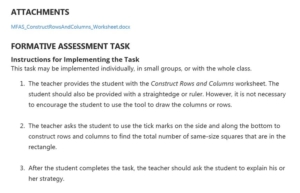MAFS.2.G.1.2 Partition a rectangle into rows and columns of same-size squares and count to find the total number of them.
Cognitive Complexity Level: 1-Recall
[divider] [/divider] Students are able to…
- Talk about and show examples of rows and columns that divide a rectangle.
- Explain how the shape was divided into squares and count to find the total number of squares.
[divider] [/divider] Students are able to…because teachers:
- Plan tasks that make connections between equal sharing and partitioning with rectangles. These connections start to build the conceptual understanding of multiplication.
- Provide opportunities for students to use tiles to cover a rectangle. They can discuss this by explaining the number of rows and columns of squares that were used. (For example, 2 rows of 5 squares covered the rectangle.)
- Help students make the connection between using the physical tiles and the pictorial representation that students are then able to draw themselves.
[divider] [/divider] Questions to ask students:
- Ask: Give the student a rectangle and ask him/her to use tiles to cover it. Ask the student how many tiles it takes? Ask the student to use the words row and/or column to describe the number of tiles used.
- Sample answer that would indicate understanding: The student will use the tiles to cover the rectangle with no overlapping tiles or big spaces. The student will the correctly tell the number of tiles used. The student will then be able to use the words row and column correctly. For example: There are 15 tiles. There are 3 rows of 5 tiles. OR There are 5 columns of 3 tiles.
- Sample answer that indicates an incomplete understanding or a misconception: The student will incorrectly count the tiles and/or incorrectly use the terms row and column. For example, in the above model, the student may say that there are 5 rows of 3 tiles OR 3 columns of 5 tiles.
[divider] [/divider] Additional Resources:
Additional in depth content knowledge
Video: Partition rectangles into same-sized squares by creating columns and rows
[divider] [/divider] Sample Formative Assessment Tasks:
[divider] [/divider] Resources/Tasks to Support Your Child at Home:
- Give your child an index card or piece of rectangular paper. Have them fold it into equal rows and columns such as 3 rows of 4. Have them describe how the rectangle had been decomposed using math language. Have them record an equation and how many total square units there are.
- Khan Academy: Equal Parts of Circles and Rectangles
